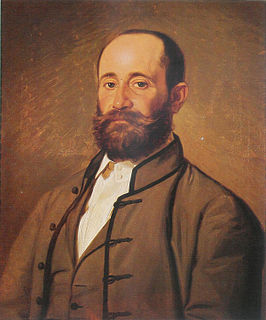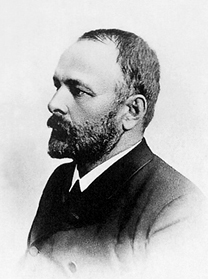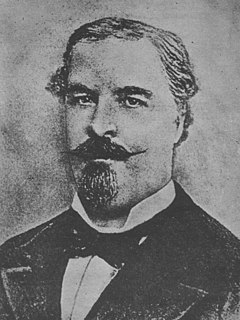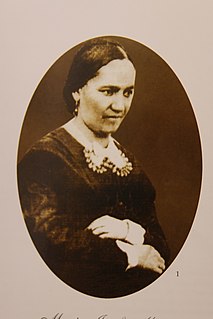 W
WVasil Barnovi was a Georgian writer popular for his historical novels.
 W
WMercedes Cabello Llosa de Carbonera was a Peruvian writer. Influenced by positivism and naturalism. She was one of the main the initiators of literary realism in Peruvian novels. She wrote six novels of social content and critical intent, the most successful Blanca Sol (1888), Las consecuencias (1890) and El conspirador (1892). She also wrote numerous articles and essays published in Peruvian newspapers on literary and social topics. She especially advocated the emancipation of women, and was one of the first Peruvian feminists. She was a contemporary of Manuel González Prada, who, like Cabello, was a sui generis positivist; and an attendee of Juana Manuela Gorriti's tertulias, which provided her an opportunity to meet other female writers and discuss literature and feminist ideologies. Her literary works Sacrificio y recompensa, Blanca Sol, Las consequencias and El conspirador contain a repeating theme of women portrayed as " helpless, suffering creatures or as fallen heroines." This is another one of her most prominent themes in her writings. Another common topic is her criticism of the pervivan bourgeoisie, Lima's social elites, between 1860-1880.
 W
WPrince Ilia Chavchavadze was a Georgian writer, political figure, poet, and publisher who spearheaded the revival of the Georgian national movement in the second half of the 19th century, during the Russian rule of Georgia. He is Georgia's "most universally revered hero."
 W
WDaniel Chonkadze was a Georgian novelist primarily known for his resonant novella Suramis tsikhe.
 W
WAnastasia Eristavi-Khoshtaria was a Georgian woman novelist.
 W
WSami bey Frashëri was an Albanian writer, philosopher, playwright and a prominent figure of the Rilindja Kombëtare, the National Renaissance movement of Albania, together with his two brothers Abdyl and Naim. He also supported Turkish nationalism against its Ottoman counterpart as well as laicism against theocracy.
 W
WJakov Ignjatović was a novelist and prose writer, who primarily wrote in Serbian but also in Hungarian.
 W
WElfriede Jaksch (1842–1897) was a German language Latvian writer. She wrote a number of popular novels and novellas under the pen name Shack von Igar.
 W
WAlexander Kazbegi (1848–1893) was a Georgian writer, famous for his 1883 novel The Patricide.
 W
WAntun "Ante" Kovačić was a Croatian writer who is best known for his magnum opus work U registraturi.
 W
WJosip Kozarac was a Croatian writer.
 W
WEugen Kumičić was a prominent Croatian writer and politician. Kumičić was one of the most prolific Croatian novelists of the realism era and a pioneer of naturalism in Croatian literature.
 W
WJosé Victorino Lastarria was a Chilean writer, legislative deputy, senator, diplomat, and finance minister.
 W
WEduarda Damasia Mansilla Ortiz de Rozas de García (1834–1892) was a noted Argentine writer.
 W
WAbraham Mapu was a Lithuanian novelist. He wrote in Hebrew as part of the Haskalah (enlightenment) movement. His novels, with their lively plots encompassing heroism, adventure and romantic love in Biblical settings, contributed to the rise of the Zionist movement.
 W
WLuis Alfredo Martínez Holguín was an Ecuadorian writer, painter, politician, and agriculturist. He introduced Realism into Ecuadorian literature. He was an opponent of the government of Eloy Alfaro. He worked in different regions and at various jobs, from the humblest to the most prestigious, and knew about the life of the people, which allowed him to write his masterpiece, A la Costa (1904), one of Ecuador's first realist novels, describing faithfully the social changes taking place in his country in the late nineteenth century.
 W
WSimo Matavulj was a Serbian writer.
 W
WClorinda Matto de Turner was a Peruvian writer who lived during the early years of Latin American independence. Her own independence inspired women throughout the region as her writings sparked controversy in her own culture.
 W
WJosé Milla y Vidaurre was a notable Guatemalan writer of the 19th century. He was also known by the name Pepe Milla and the pseudonym Salomé Jil. Son of a governor of the state of Honduras in the Federal Republic of Central America, José Justo de la Milla y Pineda and Mrs. Mercedes Vidaurre Molina, the daughter of a wealthy Guatemalan family. He was married to his cousin, Mercedes Vidaurre and had 7 daughters and sons.
 W
WFray Mocho was the pen name for the Argentine writer and journalist José Ciriaco Alvarez. He moved to Buenos Aires first in 1876 and then again to stay in 1879 at the age of 21. He was known to his friends as "Mocho" (blunt) and later added the title "Fray". He wrote for several newspapers including El Nacional, La Pampa, La Patria Argentina, and La Razón. He also wrote for magazines such as the short-lived Fray Gerundio, El Ateneo and La Colmena Artística. He wrote essays about life in Buenos Aires in the latter part of the 19th century, including Esmeraldas (polished), Cuentos Mundanos, La vida de los ladrones célebres de Buenos Aires y sus maneras de robar and Memorias de un Vigilante. In 1898 he wrote the book En el Mar Austral.
 W
WMaría Josefa Mujía (1812–1888) was a Bolivian poet. Blind from the age of 14, she was one of Bolivia's first Romantic poets and is considered the country's first woman writer following its independence. Her poetry was lauded for its sincerity and lyricism, while its dark and sorrowful content earned her the moniker "la Alondra del dolor".
 W
WĠużè Muscat Azzopardi was a Maltese lawyer, poet, novelist and social commentator. He studied in the Mdina Seminary, and in the University of Malta, where he graduated as a lawyer in 1875. He was married to Tonina Fenech, and had three sons Ivo and Ġino, who were both writers, and Anton, a composer.
 W
WVjenceslav Novak was a Croatian Realist writer, dramatist, and music historian.
 W
WYervant Odian more known by his satire name "Comrade Panchooni", is considered to be one of the most influential Armenian satirists, along with the roughly contemporary Hagop Baronian. Odian was born into one of the most affluent families in what was then Constantinople. His Paternal Uncle Krikor Odian (1834-1887) was a respected political figure and was even one of the founders and writers of the Armenian National Constitution. His father too was a writer, along with having been a political diplomat and possibly most unique of all, a translator of Victor Hugo's. Odian's mother was indeed wealthy on her side of the family as well. Odian's writings, which include novels and short stories, often humorously point out humanity's vices. Odian's heritage played a major role in some of his major themes, those being Armenian-Turkish relations as well as Muslim-Christian relations. Interestingly enough, Odian's grandfather Yazedje Boghos Agha was from Palu, Turkey, a town notable for its massive Armenian population, a major part of its destruction during the Armenian massacre events of the 1894-1896. He had the unique ability to conceive of and write stories at any given instant. In a 2013 piece written by Eddie Arnavoudian, he proclaimed "Even if elsewhere equalled in modern Armenian literature, Odian's exposure of the establishment's putrid core has certainly not been bettered". Odian's writing styles are often described as extroverted, as if his is removing his persona from the piece in order to best portray the truth. Though Odian was surrounded by nearly all of the other great Armenian writers of his time, and friendly with many of them, their writing styles never altered his own, always staying true to his voice.
 W
WPavlina Pajk, née Doljak was an early Slovene poet, novelist, essay writer and biographer.
 W
WJosé Protasio Rizal Mercado y Alonso Realonda was a Filipino nationalist and polymath during the tail end of the Spanish colonial period of the Philippines. He is tagged as the national hero of the Filipino people. An ophthalmologist by profession, Rizal became a writer and a key member of the Filipino Propaganda Movement, which advocated political reforms for the colony under Spain.
 W
WAugust Ivan Nepomuk Eduard Šenoa was a novelist. Born to an ethnic German and Slovak family, Šenoa became a key figure in the development of an independent literary tradition in the Croatian language and shaping the emergence of the urban Croatian identity of Zagreb and its surroundings at a time when Austrian control was weaning. He was a literary transitional figure, who helped bring Croatian literature from Romanticism to Realism and introduced the historical novel to Croatia. He wrote more than ten novels, among which the most notable are: Zlatarovo zlato, Čuvaj se senjske ruke, Seljačka buna, and Diogenes (1878).
 W
WStevan Sremac was a Serbian realist and comedy writer. He is considered one of the best truly humorous Serbian writers.
 W
WAisha E'ismat Taymur was an Egyptian social activist, poet, novelist, and feminist in the Ottoman era. She was active in the early 19th century in the field of women's rights. Her writings came out in a period of time where women in Egypt were realizing that they were being deprived of some of the rights that Islam granted them. Taymur was one of the earliest Arab women to be alive while her poetry and other writings were recognized and published in modern times.
 W
WTorfhildur Þorsteinsdóttir, also known as Torfhildur Hólm was an Icelandic author who lived for many years in Canada. She was perhaps the first Icelander to make a living as an author, and is frequently cited as the first Icelandic woman novelist.
 W
WJanko "Jan" Veselinović was a Serbian writer, influenced by Milovan Glišić, Milan Đ. Milićević, Đura Jakšić, and Rusyn writer Marija A. Markovič, who went under the assumed name of Marko Vovčuk.